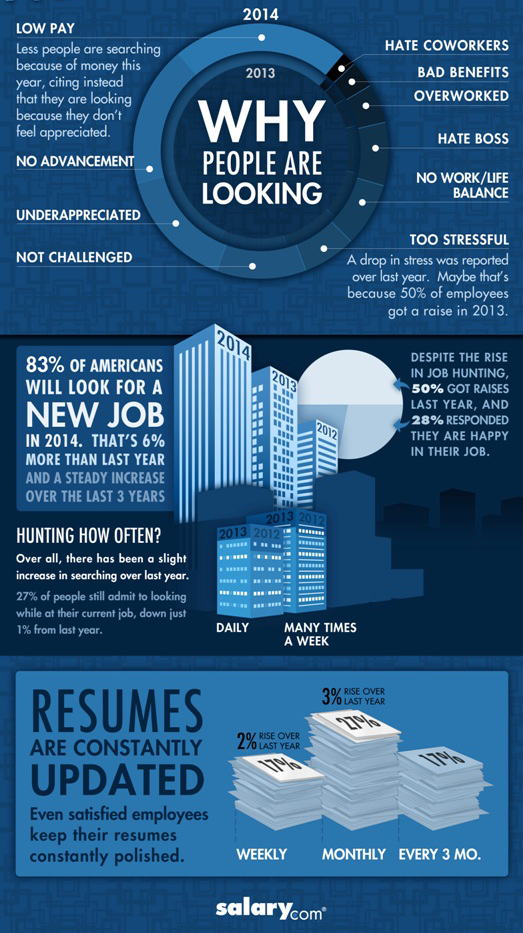
This year’s employee engagement forecast results are in from Salary.com. According to the popular site, your employees are 23% happier with their job than they were in 2013, but 83% say that they will still actively look for a new position in 2014. The January Job Seekers survey, taken by over 1,200 people, asked how currently employed people felt about their employers, reasons to stay and reasons to leave. The results spoke volumes about the amount of employee engagement that their workplace provided, as the main reasons to leave could have been addressed during the hiring process. Here are the top ten reasons why they are not only keeping their resume updated, but also sending it out while on the job:
Low pay: 16%
Of the respondents who plan to look for a job, 50% were given a raise in 2013. While pay will always be a factor in job seekers list of priorities (29% said that a pay raise would keep them with their current employer), it is clear in 2014 that employees are making the switch for other reasons.
No possibility of advancement: 15%
Depending on company structure, employers may not be able to create new positions but what they can focus on is how they engage their employee. Continued learning or training can really help an employee grow professionally, leading them to a position that they may not have been qualified for previously. A few cited reasons for employees to stay that may help in this area are clearer career goals or moving to a new team. Continued learning can help employers engage with their employees to achieve this.
Underappreciated: 13%
Part of feeling under appreciated can be tied to low pay, however there are also other reasons. 3% of respondents said that more recognition could make them happier at work, which can be as simple as team lunches, a call out at company meetings and making sure that you are aware of achievements made by your team members.
Not challenged: 8%
This is a clear sign of a disengaged worker. Lack of challenge leads to boredom, and while they may like your work culture they will most definitely be looking for something new. One way to foster employee engagement is to take a look at the training that your company offers, or could offer, and make employees aware. It is in your best interest to help employees grow.
Hate boss: 5%
When employees have issues with their manager, it’s important to look at your own hiring process. This issue could be prevented up front by making sure that the candidate fits in with the managerial style during the interview process. However, if you have already hired the employee, 9% said that switching to a new boss would be preferable if at all possible.
Work/Life balance: 5%
10% of respondents said that if work/life balance were improved, they would consider staying, and 5% said a flexible schedule would be preferable. If you’re able, work with your HR department on ways to make your team’s schedule fit their lifestyles.
Job stress: 4%, Overworked: 3% and Benefits: 2%
I’ve lumped these three together not because they are similar, but because they can be prevented during the hiring process. Painting a very realistic picture of your workplace is incredibly important in the interview process. Remember that while you are interviewing them, and expecting the candidate to give specific and honest answers, you must also be up front about expectations, level of stress they may encounter and also make sure that they are very aware of the benefits that you will be providing.
Bad coworkers: 1%
Like confrontation with management, this is also something to think about during your hiring process. If you don’t already, introduce candidates to their potential future team. While it may not entirely show how this person would get along in an actual work setting, it is one way to see the dynamics of what could be.

